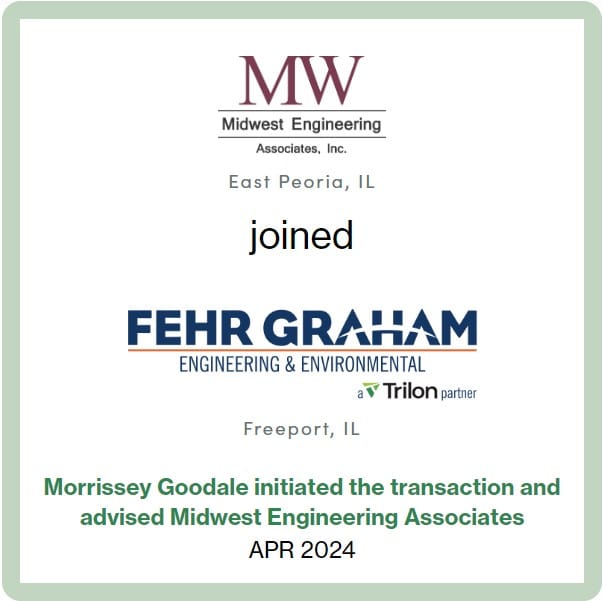Word on the street > By the Time You’ve Read This…; Dry Those Tears, Gen X…I Didn’t Forget You Like Everyone Else Has
Word on the Street: Issue 193
Weekly real-time market and industry intelligence from Morrissey Goodale firm leaders.

By the Time You’ve Read This…
….another AE and environmental consulting industry firm will have been acquired. One-plus merger a day. That’s the pace that consolidation of the design and environmental consulting industry has been running at for the past few years. And there’s no sign of a slowdown. Recently, Jon Escobar and Nick Belitz of our advisory business shared their consensus forecast for over 450 transactions this calendar year. The hits keep coming.
This ongoing wave of consolidation is affecting national, regional, and local competitive environments. It’s changing in real time how firms approach sales, marketing, and recruiting. In some states, the primary competitive change comes from intra-state M&A (one firm headquartered in the state acquires another), effectively reducing competition. In others, out-of-state acquirers are entering the market, upending the status quo. When it comes to the 13 Western U.S. states, both of these dynamics can be seen in action. Here are some highlights…
1. California: The Golden State has traditionally seen the most M&A activity on an annual basis of any of the 13 Western U.S. states. (Indeed, it annually rivals Texas for the most deals nationally in any given year.) Since 2021, the state has seen close to 170 transactions, with a record 62 of those being consummated in 2021. Statewide M&A-driven competitive changes: The most frequently observed deals in California are intra-state, accounting for one of every three acquisitions. This is a result of the state essentially being two distinct regional markets—Northern and Southern. To operate statewide, a firm needs a presence in both markets, thus the healthy intra-state deal flow. Deals completed by Florida-based firms and firms headquartered in New York yield the second- and third-most frequently observed transactions in California—accounting for 8% and 7%, respectively, since 2021. These are typically larger (ENR 500) East Coast AE and environmental consulting firms expanding to the West Coast as part of a “national firm” strategy.
2. Colorado: Colorado is perennially a distant second to California when it comes to deal volume in the 13 Western states. Since 2021, the industry in the Centennial State has experienced 55 acquisitions. The last two calendar years have been particularly frothy with 20 deals in each of 2022 and 2023. Statewide M&A-driven competitive changes: Unlike California, it’s out-of-state players that are primarily driving changes in the Colorado competitive landscape. Firms headquartered in California and Illinois accounted for one quarter of the transactions in the state over the past three-plus years. Acquisitions in the first cohort represent elements of an aggressive Western U.S. regional growth strategy by California-based firms, while acquisitions in the second cohort are examples of Illinois-based firms seeking out higher-growth markets.
3. Washington: There have been 42 transactions of AEC firms in the Evergreen State since 2021—encompassing all service types and end markets. Last year saw a record 13 firms change hands. Statewide M&A-driven competitive changes: Intra-state deals accounted for 20% of transactions in Washington. Acquirers from California and Texas accounted for 16% and 10%, respectively, of transactions in the state since 2021. It’s not unexpected to see California firms use acquisitions to extend their businesses northwards. It is somewhat surprising to see this number of transactions by Texas-based firms.
4. Arizona: The Grand Canyon State continues to rank highly as a target market for East Coast and Midwest firms seeking to follow population-driven development and infrastructure opportunities. Since 2021, there have been 30 transactions in the state with a record 13 of those taking place in 2022. Statewide M&A-driven competitive changes: A deeper dive shows that firms from three states—Florida, Texas, and Iowa—have been the primary drivers of consolidation in Arizona since 2021, accounting for 37% of all acquisitions. This Southwest state is seeing its competitive environment upended by growth-minded players from the Southeast, South, and Midwest.
5. Keep an eye on Hawaii, Montana, and New Mexico: The Aloha and Treasure States and the Land of Enchantment have all experienced consolidation through M&A since 2021. And in each of the three states, 100% of the deals were a result of out-of-state acquirers buying a presence in the state. In Hawaii, all acquisitions since 2021 have been made by just one firm outside of Washington State. Montana has seen its competitive environment disrupted by a smorgasbord of acquirers from Wyoming, Minnesota, Illinois, Louisiana, and California, while in New Mexico new entrants to the state have come from Massachusetts and Virginia. States with relatively few major metro areas and relatively smaller populations are notoriously hard for out-of-state firms to grow in organically, so this pattern is not all that surprising. What will be interesting to see is how many in-state firms remain independent over the next decade in these three states as they face leadership and capitalization challenges.
A deeper dive: For more on how consolidation is playing out in the Western United States, and to network with over 200 industry executive and investors from the West and all across North America, register for our 10th annual Western States M&A and Business Symposium being held at the beautiful Wynn Hotel, Las Vegas, June 12 through 14.
M&A Best Practices Award application window is open: There’s still time to apply for this year’s M&A Best Practices Award. If you wish to be considered, we invite you to complete the simple application form here. The application should take no more than 20 to 30 minutes to complete. Applications are being accepted until May 17. The award recipient will be notified in early June with the award presented at the Western States M&A and Business Symposium in Las Vegas later in June.
Questions? Insights? Email Mick at [email protected] or text him at 508.380.1868.
Dry Those Tears, Gen X…I Didn’t Forget You Like Everyone Else Has
If you read my article from two weeks ago, “Baby Boomer Business Speak Translator,” you may have noticed that Gen X was missing from the discussion.
Then again, if you aren’t a member of Gen X, there’s a good chance you didn’t.
The Forgotten Generation
Gen X often does seem like the “forgotten generation” sandwiched between the larger and more vocal baby boomer and millennial cohorts. Why is that? Well, there are several reasons:
• Gen X is a smaller generation compared to baby boomers and millennials—by 7-10 million people (depending on the source). As a result, they may not have the same demographic clout or cultural influence, leading to less media attention and representation in popular culture.
• Gen X came of age during a transitional period in history, between the idealism of the baby boomer era and the digital revolution of the millennial generation. This liminal position has made it harder to define Gen X’s identity and cultural impact compared to the more clearly delineated narratives of the preceding and following generations.
• When Gen Xers are portrayed in popular culture, they are often depicted as disaffected and cynical (for proof, look no further than Beavis and Butthead—the definition of apathy, lack of ambition, and disdain for authority), which may contribute to their perception as the forgotten generation. They are sometimes overlooked in discussions about generational issues, with more attention paid to the idealism of baby boomers or the activism of millennials.
• Baby boomers have held significant positions of power and influence in politics, business, and media, leading to more attention on their generation’s perspectives and experiences. Millennials, on the other hand, are currently the largest generation in the workforce and are often seen as the drivers of cultural and economic change, garnering substantial media coverage as a result.
The Gen X Influence
Despite these dynamics, Gen Xers have shaped many aspects of modern culture, whether playing a pivotal role in molding the digital landscape (e.g., Elon Musk, Jeff Bezos), revitalizing the music scene (insert your ’80s and ‘90s bands of choice here), or pushing cinematic bounds (e.g., Quentin Tarantino, Richard Linklater).
Gen X is also the “bridge” generation between baby boomers and millennials, serving as a cultural and technological intermediary between the two cohorts. Here’s how:
• Gen Xers grew up during a time of significant cultural transition, witnessing the tail end of analog life while also embracing the advent of digital technology. In their youth, they experienced the rise of personal computers, the internet, and mobile phones, but they also remember a time before these technologies were ubiquitous. This unique position allows them to understand and appreciate both eras.
• Their values tend to be a blend they adopted from both baby boomers and millennials. Like baby boomers, they value hard work, independence, and skepticism towards authority. But at the same time, they share some of the progressive ideals and technological fluency of millennials, making them adaptable to change and open to innovation.
The Gen X CEO
While baby boomer CEOs often embody traits such as authority, hierarchy, and a focus on long-term stability, Gen X CEOs bring their own set of strengths and perspectives to leadership roles in AE and environmental consulting firms. Pragmatic, independent, and tech-savvy, they value work-life balance, results-driven approaches, and adaptability in the face of change. As they manage teams composed of baby boomers, millennials, and Gen Zers, Gen X leaders must navigate the diverse preferences, motivations, and communication styles of each generation to foster a cohesive and high-performing work environment.
Challenges
While Gen X leaders possess valuable skills and experiences, they often encounter challenges in effectively leading a multi-generational workforce, such as differences in communication preferences across generations, balancing the stability sought by older employees with the desire for purpose and flexibility from younger generations, and embracing innovation and change while avoiding chaos. To overcome these challenges, Gen X CEOs can:
• Embrace multi-channel communication: Recognize and accommodate diverse communication preferences by leveraging tools such as Slack, Microsoft Teams, and videoconferencing. Foster open and transparent communication channels to facilitate collaboration and feedback across generations, while sprinkling in face-to-face meetings to provide personalized feedback and support.
• Foster cross-generational collaboration: Create opportunities for knowledge-sharing and collaboration between different age groups within the firm by introducing cross-functional projects to harness the collective strengths of each generation and promote mutual understanding and respect (e.g., conduct a comprehensive assessment of the firm’s current environmental impact, identifying areas for improvement, and developing strategies to enhance sustainability across operations).
• Invite two-way mentoring: Create a “reverse mentoring program” or a “cross-generational mentoring program” by pairing younger employees with more experienced Gen X mentors who provide guidance, support, and career advice based on their years of expertise and knowledge. At the same time, younger mentees offer insights, perspectives, and expertise in areas such as technology, social media, and emerging trends, providing valuable learning opportunities for their mentors. Through this cross-generational mentoring exchange, both mentors and mentees benefit from the opportunity to learn from each other, bridge generational divides, and contribute to a culture of continuous learning and development within the organization.
The AEC industry’s Gen X CEOs stand at the intersection of tradition and innovation, equipped with a wealth of experience and a keen eye on the future. They have the opportunity to bridge generational divides, drive transformative change, and shape the trajectory of their firms and the industry—even if no one knows they’re doing it.
Questions? Comments? Text or call Mark Goodale at 508.254.3914 or email [email protected].
Market Snapshot: State Real GDP (Part 2)
Last week, we shared real gross domestic product (GDP) data and highlighted the winners and losers based on the latest release from the Bureau of Economic Analysis (BEA). North Dakota had the highest percentage economic growth in 2023, reaching 5.9% above 2022. This means that the state added $2.3 billion to the economy. Which industries contributed the most to these results?
As you might have guessed, a significant portion of the growth in North Dakota (just about half) was generated by the mining, quarrying, and oil and gas extraction industry. Other noteworthy contributing industries included real estate and rental and leasing, construction, manufacturing, and retail trade.
Another state with significant economic growth was Texas, which had a 5.7% increase in GDP in 2023. Although the Lone Star State lagged North Dakota in relative terms, it grew by nearly $109 billion, almost double the levels in California ($66 billion) and Florida ($61 billion). The oil and gas industry contributed to about a third of the economic growth in Texas. Real estate and professional and business services were the next top-producing industries in the state last year.
Wyoming, Oklahoma, and Alaska are the next states that make up the top-five list in terms of percentage GDP growth in 2023. Economic expansion in these states was also primarily driven by the oil and gas industry.
For the latest insights on U.S. regions and AE markets, check out our 2024 AE Market Intelligence Webinar. Click here to access recording and materials.
To learn more about market intelligence data and research services offered by Morrissey Goodale, schedule an intro call with Rafael Barbosa.
Weekly M&A Round Up

Congratulations to GradyMinor (Bonita Springs, FL): The civil engineering, land development, and municipal engineering consulting services firm joined Pape-Dawson Engineers (San Antonio, TX) (ENR #112), a civil engineering, environmental, and surveying services firm. The acquisition is part of Pape-Dawson’s growth strategy to expand its industry-leading multidisciplinary engineering practice across the United States. We’re thankful that the GradyMinor team trusted us to initiate and advise them on this transaction.

Another congrats to Midwest Engineering Associates (East Peoria, IL): The firm that specializes in civil/site, transportation, hydraulic, structural, MEP, land surveying, and landscape architecture services joined Fehr Graham (Freeport, IL) (ENR #471), a civil engineering, structural engineering, safety, and environmental services firm. For Fehr Graham, Midwest Engineering’s established structural and transportation engineering services combined with expertise in mechanical and electrical engineering align with strategic growth objectives. We feel privileged that the Midwest Engineering team trusted us to initiate and advise them on this transaction.
Industry consolidation continues to rebound to its peak levels: Currently U.S. deal activity is down 2% year-over-year. At the start of the year U.S. deal activity over the same period of time was down 11%. We are on track for another busy year in industry consolidation as we expect to surpass 2023 levels towards peak levels that were seen in 2022. You can check all the week’s M&A news here.
June 12-14, 2024 Las Vegas, NV
Western States M&A and Business Symposium
Join us for the 10th annual Western States Symposium, bringing together over 200 AE and environmental industry executives and investors in one of the world’s most vibrant and iconic cities.
Learn More

Searching for an external Board member?
Our Board of Directors candidate database has over one hundred current and former CEOs, executives, business strategists, and experts from both inside and outside the AE and Environmental Consulting industry who are interested in serving on Boards. Contact Tim Pettepit via email or call him directly at (617) 982-3829 for pricing and access to the database.
Are you interested in serving on an AE firm Board of Directors?
We have numerous clients that are seeking qualified industry executives to serve on their boards. If you’re interested, please upload your resume here.
Subscribe to our Newsletters
Stay up-to-date in real-time.











